|
abot92-3
|
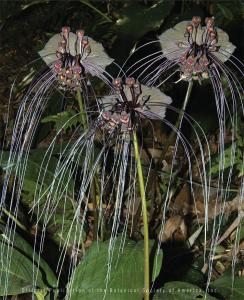
|
Tacca chantrieri in the shady understory of a tropical forest in Yunnan Province, China. The striking floral display involves dark-purple pigmented flowers and bracts, and extended whisker-like bracteoles. In Tacca, these traits have been assumed to function as a deceit syndrome in which reproductive structures resemble decaying organic material attracting flies that facilitate cross-pollination (sapromyiophily). However, experimental studies of the pollination and mating biology of T. chantrieri in China cast doubt on this hypothesis by demonstrating that most seed produced in populations is the result of autonomous self-pollination.
|
copyright: Qing-Jun Li, BSA
license: http://images.botany.org/index.html#license |
Image
|
Reproductive Biology

|

|
|
abot92-4
|
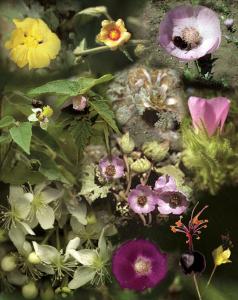
|
The tribe Malveae (subfamily Malvoideae, Malvaceae), with approximately 70
genera that grow in a variety of habitats in both tropic and temperate areas,
has remarkably diverse flowers. The phylogenetic analysis of ITS sequence data
revealed two large clades in the tribe in the article by Tate et al.: Phylogenetic
relationships within the tribe Malveae (Malvaceae, subfamily Malvoideae) as
inferred from ITS sequence data. 1. Gaya atiquipana, coastal Peru;
2. Sida cordifolia, Magdalena Valley, Colombia; 3. Iliamna
bakeri, Shasta County, California, USA; 4. Dendrosida cuatrecasasii,
Central Cordillera of Colombia; 5. Sidasodes colombiana, Eastern Cordillera,
Colombia; 6. Nototriche pedicularifolia, Andes of Peru; 7. Tarasa
humilis, Andes of Argentina; 8. Malacothamnus palmeri, Monterey
County, California, USA; 9. Hoheria populnea, New Zealand; 10. Callirhoë
involucrata, Travis County, Texas, USA; and 11. Sidastrum paniculatum
from Ecuador.
|
copyright: Javier Fuertes Aguilar, et al., BSA
license: http://images.botany.org/index.html#license |
Image
|
Systematics

|

|
|
abot92-5
|
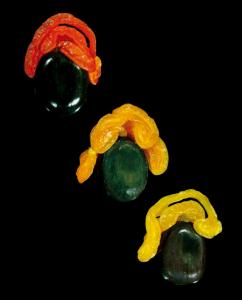
|
Fruit color polymorphisms are striking examples of intraspecific genetic variation
in plants that can interact with animal associates such as seed dispersers.
Diaspores of the Australian desert shrub Acacia ligulata (Fabaceae)
are composed of a black seed (ca. 5 mm in length) surmounted by a colored, lipid-rich
aril (ca. 2.5 mm). The three color morphs-red, orange, and yellow-are dispersed
by both ants and birds.
|
copyright: Kenneth D. Whitney, BSA
license: http://images.botany.org/index.html#license |
Image
|
Population Biology

|

|
|
abot92-6
|
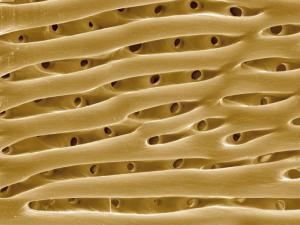
|
Scanning electron micrograph of wood of Marcgravia umbellata (Marcgraviaceae),
a lianous native of the neotropics, showing coalescent pits in the inner wall
of a vessel element (pit apertures ca. 2-3 ;gmm). Despite some characteristic
features related to the lianous habit, such as wide vessels that co-occur with
narrow vessels, axial parenchyma in proximity to vessels, and wide multiseriate
rays, the wood of Marcgraviaceae can be linked to its close relative Tetrameristaceae
s.l.
|
copyright: Frederic Lens, BSA
license: http://images.botany.org/index.html#license |
Image
|
Anatomy and Morphology

|

|
|
abot92-7
|
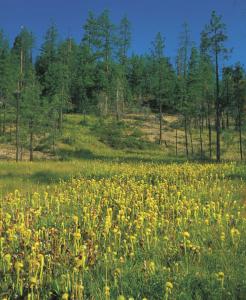
|
Scaling relationships among photosynthetic rate, foliar nutrient concentration,
and leaf mass per unit area (LMA) have been observed for a broad range of plants.
Leaf traits of the carnivorous pitcher plant Darlingtonia californica,
endemic to southern Oregon and northern California, USA, differ substantially
from the predictions of these general scaling relationships; net photosynthetic
rates of Darlingtonia are much lower than predicted by general scaling
relationships given observed foliar nitrogen (N) and phosphorus (P) concentrations
and LMA. At five sites in the center of its range, leaf traits of Darlingtonia
were strongly correlated with elevation and differed with soil calcium availability
and bedrock type. The mean foliar N : P of 25.2
|
copyright: Aaron M. Ellison, BSA
license: http://images.botany.org/index.html#license |
Image
|
Ecology

|

|
|
abot92-8
|
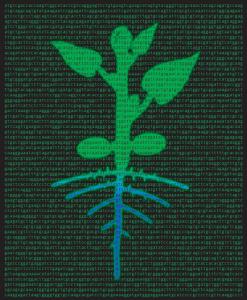
|
The classic schematic plant of J. von Sachs (Physiology of Plants. 1887. Clarendon Press, Oxford, UK) is superimposed onto repeats of the phytochrome DNA sequence to represent the plant body as an
|
copyright: Michael L. Christianson, BSA
license: http://images.botany.org/index.html#license |
Image
|
Special Invited Paper

|

|
|
abot92-9
|
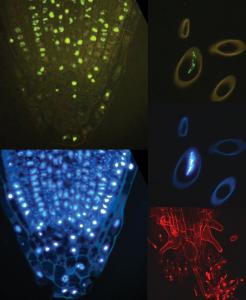
|
DNA fragmentation characteristic of programmed cell death (PCD) was detected
in NaCl-treated determinate primary roots of Stenocereus gummosus (Cactaceae)
using the terminal deoxynucleotide transferase-mediated dUTP nick-end labeling
(TUNEL) assay. Nuclei in the bottom left image, a longitudinal section of a
root tip after PCD-inducing NaCl treatment, fluoresce blue after 4'-6-diamidino-2-phenylindole
(DAPI) staining. Those nuclei undergoing DNA fragmentation fluoresce green in
the same section (top left, fluorescein-isothiocyanate [FITC] staining). During
root development, PCD was not involved in meristem exhaustion, but did occur
in root-hair and root-cap cells. Both DNA and nuclear fragmentation were detected
in a root-hair cell (right: top, FITC; middle, DAPI). Dead remnants (red-fluorescing
nuclei, propidium-iodine stain, bottom right) of the root cap lie below a root
that has terminated growth.
|
copyright: Svetlana Shishkova, Joseph G. Dubrovsky, BSA
license: http://images.botany.org/index.html#license |
Image
|
Development and Morphogenesis

|

|
|
abot93-1
|
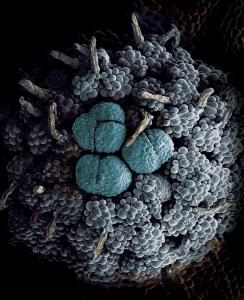
|
A scanning electron micrograph of a nearly mature flower of Lacandonia schismatica colorized to highlight the three central stamens (aqua), the surrounding carpels (steel blue), and styles (yellow). The six surrounding tepals are not shown. This paper is part of a larger project that in collaboration with local indigenous communities is aimed at collectively developing local capacity for documenting local flora and fauna and conservation of the Lacandon Rain Forest.
The cover was dedicated to Don Gabriel Aguilar, a scholar of Mesoamerican tropical flora, who collected thousands of plant vouchers for many important flora projects including Flora Mesoamericana and was instrumental in the discovery by Esteban Martinez and Clara Ramos of Lacandonia schismatica.
Link to
the AJB Abstract for the article:
Comparative developmental series of the Mexican triurids support a euanthial
interpretation for the unusual reproductive axes of Lacandonia schismatica
(Triuridaceae)
by Barbara A. Ambrose, Silvia Espinosa-Matías, Sonia Vázquez-Santana,
Francisco Vergara-Silva, Esteban Martínez, Judith Márquez-Guzmán,
and Elena R. Alvarez-Buylla
|
copyright: Ambrose, BSA
license: - |
Image
|
Anatomy and Morphology

|

|
|
abot93-10
|
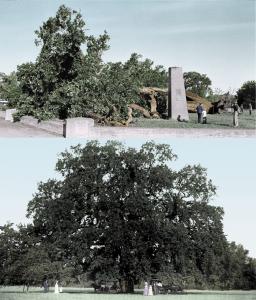
|
The "Hooker Oak" was named in honor of Sir Joseph Dalton Hooker of the Royal Botanic Gardens at Kew on the occasion of Hooker
|
copyright: Chico Enterprise-Record
license: http://images.botany.org/#license |
Image
|
Unclassified

|

|
|
abot93-11
|
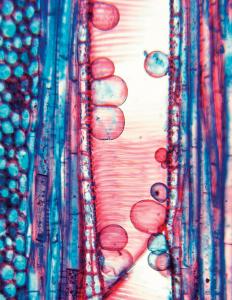
|
Tyloses are shown in a tangential longitudinal view of a secondary xylem vessel
just under a wounded surface in a current-year stem of grape (Vitis vinifera
L. cv Chardonnay). Tyloses are induced outgrowths from paratracheal parenchyma
cells that block xylem vessels as a step in wound healing. The image is a bright
field digital micrograph of a section cut with a sliding microtome and stained
with safranin and fast green.
|
copyright: -
license: - |
Image
|
Anatomy and Morphology

|

|
|
abot93-12
|
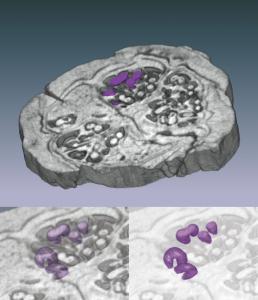
|
Three-dimensional reconstruction of the pyritized fossil fruit Palaeorhodomyrtus
subangulata (Myrtaceae) from the Lower Eocene London Clay Formation, based
on serial sections obtained from high-resolution x-ray computed tomography (HRXCT).
Upper image is a volume rendering of a 1.5-mm-thick wedge; specimen is ;10 mm
in diameter. Seeds are highlighted in purple. Lower images are volume renderings
of seeds with surrounding material made progressively more transparent, revealing
three-dimensional seed forms and arrangements. Seeds are approximately 0.4 mm
thick. This technique is applicable to many fossil and extant fruits and seeds
and provides an excellent means of imaging the three-dimensional structure of
rare, type, and figured material in a nondestructive way.
|
copyright: -
license: - |
Image
|
Paleobotany

|

|
|
abot93-2
|
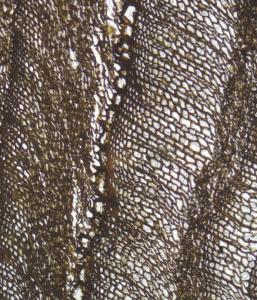
|
A light micrograph of a transverse section of fossil Metasequoia wood collected from Axel Heiberg Island, Nunavut, Canadian High Arctic, at 80
|
copyright: Visscher, BSA
license: - |
Image
|
Anatomy and Morphology

|

|
|
abot93-3
|
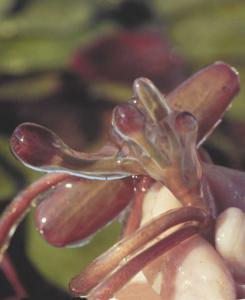
|
Cluster of submerged buds from the water lily Brasenia schreberi at various stages of development surrounded by substantial mucilage. In the first comprehensive investigation of pollen ontogeny in Brasenia, new anatomical and ultrastructural data are used to assess the evolution of pollen characters and pollination biology among water lilies and basal angiosperms.
Link to
the AJB Abstract for the article:
Pollen ontogeny in Brasenia (Cabombaceae, Nymphaeales)
by Mackenzie L. Taylor and Jeffrey M. Osborn
|
copyright: Osborn, BSA
license: - |
Image
|
Anatomy and Morphology

|

|
|
abot93-4
|
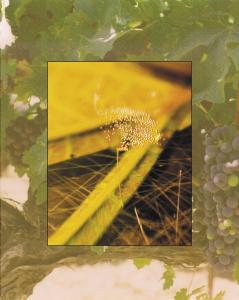
|
Air bubbles were digitally photographed as they streamed from a severed tertiary vein of a grape leaf submerged in water (inset). The camera was placed at the surface of the water. The air bubbles reveal the open, continuous xylem conduits that allow air to flow from the base of the petiole into tertiary leaf veins. Low-pressure air flow is one of the techniques used to elucidate the interconnectedness of xylem vessels across multiple organs within grapevine. Vineyardgrown Vitis vinifera cv. Cabernet Franc frames the inset.
Link to
the AJB Abstract for the article:
The structure of xylem vessels in grapevine (Vitaceae) and a possible passive mechanism for the systemic spread of bacterial disease
by Eleanor T. Thorne, Briana M. Young, Glenn M. Young, Joshua F. Stevenson, John M. Labavitch, Mark A. Matthews and Thomas L. Rost
|
copyright: Thorne, BSA
license: - |
Image
|
Anatomy and Morphology

|

|
|
abot93-5
|
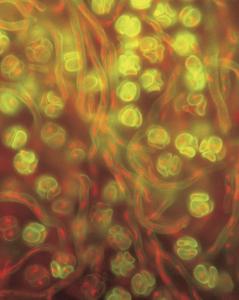
|
Autofluorescence of tetrads and elaters of the hornwort Leiosporoceros
dussii (Steph.) H
|
copyright: Blackwell/Villarreal A./BSA
license: - |
Image
|
Anatomy and Morphology

|

|
|
abot93-6
|
![abot93-6]()
|
Fluorescence in situ hybridization in a root tip metaphase squash of Nothoscordum striatum (Alliaceae) probed with concatemers of the human-type telomere motif (TTAGGG)n (biotin-labeled probe detected with cy3 avidin, red fluorescence; DAPI counterstain for DNA, blue fluorescence). The (TTAGGG)n minisatellite motif is found at chromosome ends (the telomeres). The authors showed that these motifs, and all investigated minisatellite repeats typical of eukaryote telomeres, are lost with the divergence of the genus Alllium from the rest of Alliaceae.
Link to
the AJB Abstract for the article:
Minisatellite telomeres occur in the family Alliaceae but are lost in Allium
by Eva Skorov
|
copyright: Kim/BSA
license: - |
Image
|
Cell Biology

|

|
|
abot93-7
|
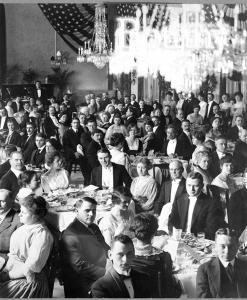
|
American botanists at the Annual Botanical Dinner at the New Ebbit Hotel, probably in Washington, D.C., 8 March 1916. The original photograph came from the estate of Homer L. Shantz via Walter S. Phillips, Botany Department, University of Arizona, College of Agriculture, Tucson, Arizona. Archives of the Botanical Society of America, St. Louis, Missouri.
|
copyright: -
license: - |
Image
|
Historical Botany

|

|
|
abot93-8
|
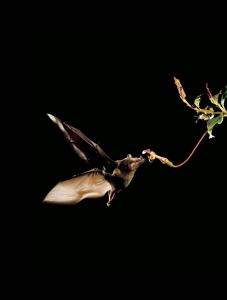
|
A glossophagine bat (Anoura geoffroyi, Phyllostomidae) visiting Burmeistera
sodiroana (Campanulaceae) in a flight cage set up in the Bellavista Cloud
Forest Reserve, Pichincha Province, Ecuador. The flower morphology fits the
bat's head closely, allowing precise and consistent pollen placement on the
crown (note the spot of pollen from a previous visit). The well-exposed flowers
of this species and eight other Ecuadorian species of Burmeistera are
dull-colored and emit strong odors and were found to be highly specialized for
bat pollination; although bats and hummingbirds visited their flowers, only
bats effectively transferred pollen. Flowers of a tenth species, B. rubrosepala,
are bright red and yellow with narrow corolla apertures and no odor and were
exclusively hummingbird pollinated.
Link to
the AJB Abstract for the article:
The pollination biology of Burmeistera (Campanulaceae): specialization
and syndromes
by Nathan Muchhala
|
copyright: Cooper/BSA
license: http://images.botany.org/#license |
Image
|
Ecology

|

|
|
abot93-9
|
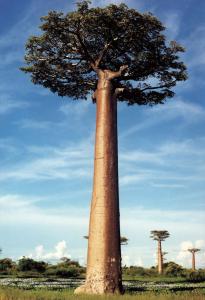
|
This baobab tree (Adansonia grandidieri) at the Allee des Baobabs in western Madagascar is now surrounded by rice fields but normally grows as an emergent canopy tree in dry deciduous forests. Baobab trees live in seasonally dry climates in Africa, Australia, and Madagascar and have long been thought to rely on water stored in their large stems. Their wood is soft and weak, however, and the large diameter and high water content of their stem contributes to overall mechanical stability. Such biomechanical constraints are likely to be more important than water storage capacity in determining their shape and could in fact limit use of stored water.
|
copyright: Chapotin/BSA
license: http://images.botany.org/#license |
Image
|
Unclassified

|

|
|
abot94-1
|
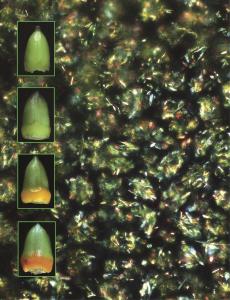
|
Model systems such as the single, large nectary embedded in the basal wall of the gynoecium (insets on left, c. 203) of tobacco (Nicotiana langsdorffii x N. sanderae Hort. Var Sutton's Scarlet) are contributing to our understanding of the cellular and molecular processes leading to the secretion of nectar, a complex mixture of compounds, near the time of anthesis. Nectary development from inception through maturity involves a number of highly integrated processes to form sugary nectar and compounds such as hydrogen peroxide and antioxidants such as b-carotene and ascorbic acid, which protect the nectar and nectary from microbial activity and auto-oxidation. Horner et al. focused on the production of b-carotene in nectary plastids as the organelles, which are filled with starch early in development, convert to being filled with b-carotene at maturity. The upper three insets show gynoecia at earlier, successive stages of development when their basal nectaries are lime green to green-orange and plastids are filling with starch and increasing in carotenoid content. In the bright orange nectary at maturity (anthesis) (bottom inset), almost all the plastid starch has been converted to sugars, bcarotene, and ascorbic acid. The background image (c. 3400) shows with polarizing optics the internal nectary tissue at anthesis, when the plastids are engorged with needle-like b-carotene crystals. The study helps elucidate the different processes associated with nectar production so that they may be manipulated to enhance the quantity and quality of nectar for attracting insects to enhance cross pollination and hybridization among crop and horticultural plants.
|
copyright: Horner, BSA
license: http://images.botany.org/index.html#license |
Image
|
Genetics and Molecular Biology

|

|